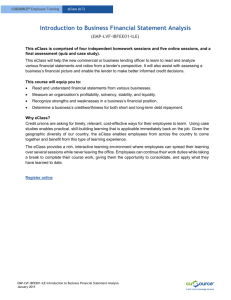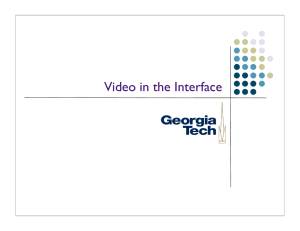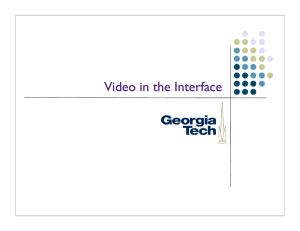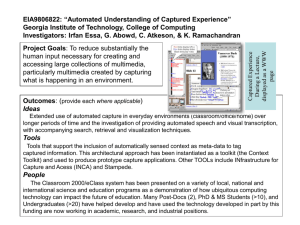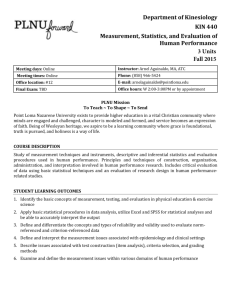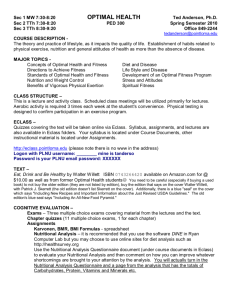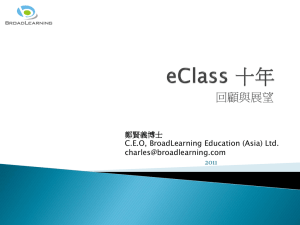Building a Digital Library of Captured Educational Experiences
advertisement
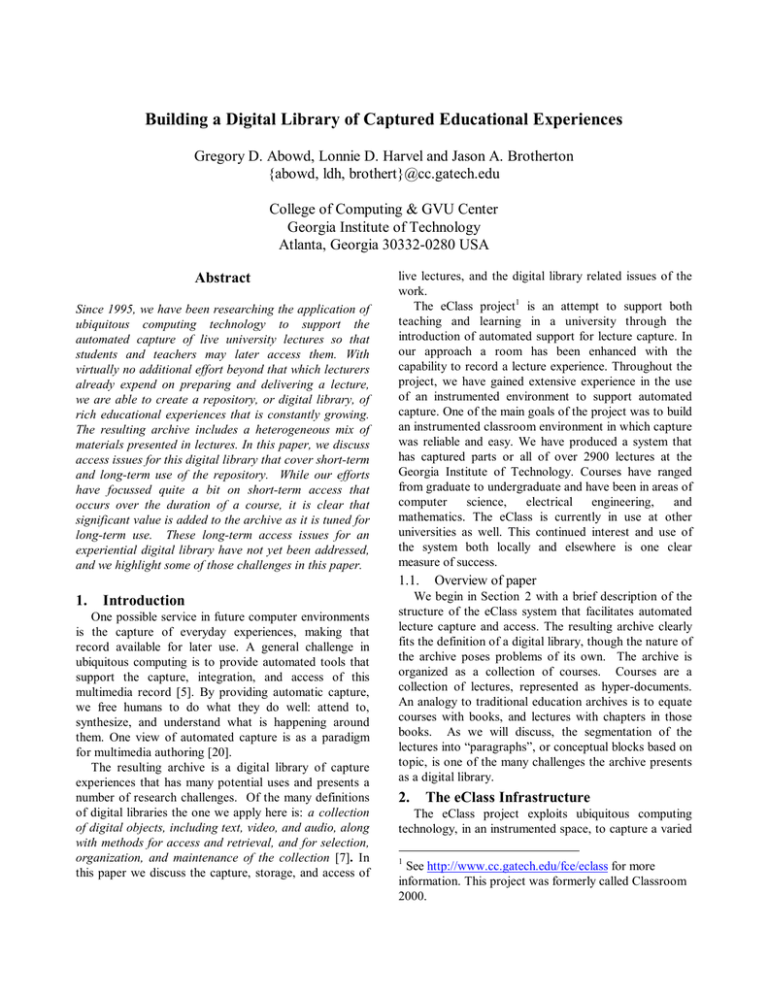
Building a Digital Library of Captured Educational Experiences
Gregory D. Abowd, Lonnie D. Harvel and Jason A. Brotherton
{abowd, ldh, brothert}@cc.gatech.edu
College of Computing & GVU Center
Georgia Institute of Technology
Atlanta, Georgia 30332-0280 USA
Abstract
Since 1995, we have been researching the application of
ubiquitous computing technology to support the
automated capture of live university lectures so that
students and teachers may later access them. With
virtually no additional effort beyond that which lecturers
already expend on preparing and delivering a lecture,
we are able to create a repository, or digital library, of
rich educational experiences that is constantly growing.
The resulting archive includes a heterogeneous mix of
materials presented in lectures. In this paper, we discuss
access issues for this digital library that cover short-term
and long-term use of the repository. While our efforts
have focussed quite a bit on short-term access that
occurs over the duration of a course, it is clear that
significant value is added to the archive as it is tuned for
long-term use. These long-term access issues for an
experiential digital library have not yet been addressed,
and we highlight some of those challenges in this paper.
live lectures, and the digital library related issues of the
work.
The eClass project1 is an attempt to support both
teaching and learning in a university through the
introduction of automated support for lecture capture. In
our approach a room has been enhanced with the
capability to record a lecture experience. Throughout the
project, we have gained extensive experience in the use
of an instrumented environment to support automated
capture. One of the main goals of the project was to build
an instrumented classroom environment in which capture
was reliable and easy. We have produced a system that
has captured parts or all of over 2900 lectures at the
Georgia Institute of Technology. Courses have ranged
from graduate to undergraduate and have been in areas of
computer
science,
electrical
engineering,
and
mathematics. The eClass is currently in use at other
universities as well. This continued interest and use of
the system both locally and elsewhere is one clear
measure of success.
1.1.
1.
Introduction
One possible service in future computer environments
is the capture of everyday experiences, making that
record available for later use. A general challenge in
ubiquitous computing is to provide automated tools that
support the capture, integration, and access of this
multimedia record [5]. By providing automatic capture,
we free humans to do what they do well: attend to,
synthesize, and understand what is happening around
them. One view of automated capture is as a paradigm
for multimedia authoring [20].
The resulting archive is a digital library of capture
experiences that has many potential uses and presents a
number of research challenges. Of the many definitions
of digital libraries the one we apply here is: a collection
of digital objects, including text, video, and audio, along
with methods for access and retrieval, and for selection,
organization, and maintenance of the collection [7]. In
this paper we discuss the capture, storage, and access of
Overview of paper
We begin in Section 2 with a brief description of the
structure of the eClass system that facilitates automated
lecture capture and access. The resulting archive clearly
fits the definition of a digital library, though the nature of
the archive poses problems of its own. The archive is
organized as a collection of courses. Courses are a
collection of lectures, represented as hyper-documents.
An analogy to traditional education archives is to equate
courses with books, and lectures with chapters in those
books. As we will discuss, the segmentation of the
lectures into “paragraphs”, or conceptual blocks based on
topic, is one of the many challenges the archive presents
as a digital library.
2.
The eClass Infrastructure
The eClass project exploits ubiquitous computing
technology, in an instrumented space, to capture a varied
1
See http://www.cc.gatech.edu/fce/eclass for more
information. This project was formerly called Classroom
2000.
set of interactions between the instructor and the
environment. The aim of the project is to allow students
to take on a more active and enriching role in the
classroom by capturing details of a live session and
making them widely available. The student accessibility
of the captured lecture experience reduces the need for
copying material; allowing for more interaction and
attention to commentary and annotation in the student
record.
The eClass system is structured in four phases — preproduction, live capture, postproduction/storage, and
access [3].
Pre-production: We made a conscious decision to
minimize the work required by an instructor in this
phase. It is possible to use the system without any
preliminary effort. However, many instructors produce
graphic slides in advance of the lecture.
Live Capture: Once a lecture begins, we attempt to
capture, with a time stamp, all of the relevant activity.
We understand the live experience as a generator of
various streams of information. For example, the set of
prepared slides that might be shown during the lecture
constitutes one stream that is divided into discrete
chunks, or slides, that appear at various times.
Handwritten notes, made either by the teacher or a
student, constitute another stream, with individual
strokes (pen-down to pen-up) defining the time-stamped
chunks. Other examples of streams include the audio or
video recorded by one or more microphones or cameras,
a series of URLs (uniform resource locators) visited with
a Web browser during a recorded session, or even a series
of user interactions with a program that is being
demonstrated during the lecture. This phase ends when
the live session, such as the class lecture, ends.
The eClass software has been used to support
activities in several classrooms and meeting rooms with
varied hardware infrastructures. The most comprehensive
hardware installation is found in the original prototype
classroom, depicted in Figure 1, which has been in
operation since January 1997. In this room, the hardware
infrastructure includes an electronic whiteboard, two
ceiling-mounted projectors, one camera and several
microphones embedded in the ceiling, all operating in
unison through a suite of client-server software modules.
C
D
B
E
A
Figure 1: The Classroom 2000 classroom is
instrumented to capture of the information presented on
the electronic whiteboard (A), captured by a videocamera in the back of the room (B) and by microphones
embedded in the ceiling (C), as well as web browsing
projected (D). Information from previous slides is
presented simultaneously in other projected screen (E)
The supporting software, referred to as the Zen*
system, performs the tasks of capturing and
synchronizing streams of information during each live
session. These tasks include controlling the capture of the
media streams (audio and video) and orchestrating the
generation of an associated document during
postproduction.
Postproduction/Storage: The whole purpose of
defining and capturing streams is to support the
development of interfaces that integrate or associate
related streams. For example, we wanted to be able to
look at any part of a lecture after class and associate it
with what was being said during that part of the lecture.
This integration activity is central to the postproduction
activity. We developed a technique for post-processing
captured lecture material that could facilitate later
browsing [11]. We currently place most of the postprocessed material in a database and file system that
facilitates a variety of interfaces to browse the captured
material..
Access: The final phase involves the student (and
teacher) access of some portion of the live lecture
experience. The interfaces used by the students are very
different from the physical interfaces used during live
capture. For example, very few students would be
expected to possess a networked, pen-based computer, so
we cannot assume that form of interaction will be
available. Since access needs to be universal and across
platforms, it is important to build on an existing
infrastructure, such as the Web. In the next two sections,
we describe some of the interfaces for accessing lecture
experiences. A more complete description of these
interfaces can be found elsewhere [2], [20].
3.
Short-term Access
The document presented in background of Figure 2 is
a sample of the hyper-documents automatically generated
with the eClass infrastructure. In this case, the frame on
the right hand-side presents the lecture as a sequence of
discrete slides as presented or created during the lecture.
The frame on the left presents a timeline decorated with
relevant activity as it happened during the lecture, either
a new slide being visited on the electronic whiteboard or
a Web page being visited on a separate display inside the
classroom. The frame on the bottom left of the window
presents the video (and audio) recording of the lecture,
played back as a RealNetworks stream. The window on
the foreground corresponds to a web page visited during
the lecture — it was open by selecting its title used to
decorate the timeline.
that lecture, or over all lectures for the course. It is also
possible to look for information in all courses or only in
selected courses using the interface shown in Figure 3.
Figure 3: Search over several courses
An alternative "advanced" interface as shown in
Figure 4 allows the user to select the lectures and content
upon which the search operations are to take effect,
which content to consider, and to specify whether or not
the search should be case-sensitive.
Figure 2: Web browsers are used for presenting the
captured notes that link presented material from the
electronic whiteboard and Web pages visited in class
with streaming digital audio/video recorded during
class
The eClass system contains a variety of sources
including: slides, captured ink, audio, video, URLs,
transcriptions of handwritten information, transcriptions
of voice, titles of web pages that have visited during a
lecture, and annotation that is added by the instructor
after a lecture.
Viewing a single lecture is a very short-term access
requirement. As a term progresses and more lectures are
captured, it is often useful to be able to browse the entire
contents of a course. We use an automatically generated
syllabus of lectures to facilitate this form of browsing.
Lectures are arranged in reverse chronological order.
Since the captured lecture information has been
loaded into a database that contains all of the information
from all other courses, a user can initiate a search over
Figure 4: Advanced search interface
Given a query, the search engine searches the
database for the specific terms. Figure 5 shows an
example of a screenshot that results from searching for
"Spiral Model" over a subset courses in the database. The
figure shows the detailed view of the search results that is
available for each lecture. Thumbnail images are shown
along with a list of where each occurrence appears.
These images serve as anchors that can be selected by the
user to view the lecture in a separate window,
automatically keyed to that specific slide.
keywords, such as system components, were discussed.
Information is not added as the timeline becomes more
focused. However, as focus increases, the individual
streams and events spread out and are easier to
distinguish.
Figure 5: Detailed view of a search for “spiral model”.
4.
Long-term Access
A typical course at Georgia Tech runs for fifteen
weeks, and consists of 45 lecture hours. This amount of
captured information can be difficult to search and
manage. This situation is compounded by the fact that
students often take several courses each term and many
more courses over their entire academic experience. The
capability of searching the content of many different
courses may help a student find a relevant piece of
information, or see how different courses are related
along a common topic.
We have not thoroughly investigated the variety of
interfaces and retrieval techniques to facilitate this longterm access task. In order to augment a users ability to
browse a large collection of captured lectures, we
prototyped a new interaction and visualization technique,
the multi-scale timeline slider, or MTS [23]. The MTS
allows a user to navigate a stream of information and
events as well as control the playback of that stream.
User controlled, multi-scale zoom is supported through a
set of individual timelines that focus the stream’s
context. The user interacts with the timelines by creating
focus regions, manipulating existing focus regions, and
manipulating the playback control.
The visualization consists of a series of individual
timelines, where each subsequent timeline is a focused
region of the previous timeline. Each timeline represents
a series of ordered streams. The recessed gray rectangles
on the timeline represent a stream. Each stream is
annotated with events, drawn as colored lines and boxes
above and below the stream. In Figure 6, the streams are
videos of meetings and the events are where different
Figure 6: The Multi-Scale Timeline Slider interface.
5.
Digital Library Challenges
We have demonstrated through the eClass system that
it is possible to overcome the difficulties of authoring
rich multimedia documents that support access to live
educational experiences. Though we have investigated
some of the long-term implications of a digital library of
these experiences [8], many challenges remain. We
outline some of these in this section.
5.1.
Indexing & Weighting
The contextual scope of a search ranges from a single
course to several courses. Since eClass records the time
of capture, searches may also be conducted over an
extended period of time.
The existing search system is based on SQL queries of
the database without the use of indices, weighted or
otherwise [20]. The use of indices would improve the
ability of the system to provide relevance searches.
However, the structure of the document creates
difficulties with traditional indexing systems.
The eClass hyper-document is not only a multicomponent artifact; it has the added dimension of time as
a contextual reference to the material. In order to
correctly index and weight a term, the system must know
in what component a term occurs, to what hyperdocument the component belongs, and at what time
within the stream the term occurs. If the granularity of
the weighted index is on the lecture level, the
information can be acquired easily from the eClass
database. However, if the intent is to provide a smaller
granularity, problems arise in aligning the individual
components temporally.
The collection is divided in two different ways, using
time.
Horizontal Time is used to align separate
components of an individual lecture. Vertical Time is
used to align individual lecture component or segments
with past or future components. The dual aspect of time
within the collection affects indexing and weighting as
well as topical analysis and summarization.
As an example of horizontal time, we consider the
lectures that contain voice transcripts. The transcript
time stamps do not align uniformly with the access times
for individual slides. One possible method is to use the
additional context of the ink strokes to assist in aligning
the transcript with the slide. However, the ink strokes
reference the time index of the audio stream, and not that
of the transcript. Though the two are close, they are not
identical. A second approach would be to use a topical
analysis of the disparate components to provide an
alignment based on the topical structure as well as the
temporal. This addresses the question of what to do
when the captured audio is not actually relevant to the
slides that occur within the same temporal slice. (that is,
an instructor engages in an extended side-track from the
original topic expressed on a slide.) This approach
requires the existence of a topical analysis, which will
require keyword selection and summarization.
The second division of the collection is based on
vertical time. One approach, built upon the semistructured nature of lecture material, is to use recurrence
in time as an element in the calculation of a compound
weight for a term [22]. Previously we discussed using
topical analysis to align contemporary streams along the
time dimension. It is also possible, assuming dependable
keyword selection, to align segments of related material
over time. Other contextual clues can be used to assist or
even guide the process of vertical alignment. In the case
of eClass, the recurrence of courses can provide a roughpass alignment of the collection.
For example, CS6750a is taught in the Fall and then
again in the Spring. Likewise, it has been taught in
previous years. This information can be used to align the
collection on the course level. Using information
collected explicitly from the slides, some alignment can
be gained on the lecture level. However, to accurately
align lectures, or more likely, segments of lectures,
analysis of information implicit in the collection must be
attained. Once a lecture, or lecture segment, has been
aligned with compatriot material from previous and
future experiences, an attempt can be made to identify
predominant keywords within the component over time.
This can provide stronger weights for material that is
covered intentionally versus those that are incidental or
only supportive of the planned material [26].
There are, of course, other issues related to the
weighting of terms within multi-component, time-
sensitive collections. Should a term found in the prepared
slides be weighted equally with a term found in the voice
transcript? Exactly how should time affect the weighting
of terms? Should terms within more recent document
components receive higher relevance weights than those
from previous semesters? Since course material is
routinely reused, the question of weighting over time is
relevant. Likewise, since faculty sometimes shares
course materials, is the authorship of one component
relevant to the weighting of that component within a
hyper-document? Is it possible to create a weighting
methodology that is independent of the lecturer, or will
the weighting depend upon the presentation style?
As mentioned earlier, the eClass system also allows
for the archiving of referenced URLs. Web pages that
are visited during the captured lecture are referenced
within the timeline of the hyper-document. This poses
another challenge to conventional indexing and
weighting. Should terms found within a referenced
website be included in the index of terms associated with
a hyper-document in the archive? If they are included,
how should they be weighted? A possible approach is to
allow terms within the web page to effect the weights of
existing terms in the hyper-document without increasing
the set of terms established by the local components.
Finally, since eClass is a heterogeneous collection of
streams, how do we accurately compare lectures or
courses, which have no transcripts, with those that have a
wider collection of material? This problem is similar to
that of comparing indices based on whole documents
with those based on abstracts only.
5.2.
Summarization
The eClass system, like other hypermedia archives,
poses challenges to the existing summarization
technologies. The multi-component nature of hyperdocuments within the archive is similar to the problem of
multi-document
summarization
[24],
[16].
Summarization of courses would pose a similar problem,
requiring the inclusion of multiple lectures. The archive
is also a multimedia collection, requiring the use of new
approaches in multimedia summarization. Since the
hyper-documents in the eClass archive contain text
components as well as media components, topical
analysis applied to the text components can be used to
augment the summarization of the media components, as
in the work done by Takeshita [27].
As a foundation to both summarization and indexing,
topical analysis of the hyper-document is an important
aspect of making the eClass archive more useable as a
library of captured educational experiences. There are
many challenges to topical analysis, which we are
beginning to explore.
As with indexing and weighting, the eClass archive
adds time to the mix, creating new challenges for
summarization as well. Summarization of material
through time, and preserving the sense of time, is
essential in an experiential archive.
Existing methods must be explored, and new methods
created to segment captured data into conceptual blocks.
Data segmentation routines and key term detection
strategies need to be developed to account for both the
multi-component nature of the hyper-document as well as
the temporal nature of the data stream. The concept of
horizontal and vertical time is also applicable to topical
analysis and summarization. When applied to the
entirety of the collection the result is a three-dimensional
representation of the generated topics. Horizontal slices
within this space represent a topical summary and
segmentation of a slide, a lecture, or an entire course,
based on the parameters requested. Vertical slices,
through time, are also possible; generating a topical
selection of relevant components through time.
Other dimensions can be added to a topic-based index
of the eClass archive: author, discipline and course level
are all possibilities.
5.3.
Storage
Currently, the eClass archive consists of almost 3000
captured lectures. We have functioned under a “disk is
cheap” paradigm for the eClass prototype. Accepting
that paradigm for now, we are faced with two
interconnected issues: what should be stored and in what
format. If the resulting hyper-documents were fixed, we
could answer the first issue by storing everything.
However, many of the eClass components are fluid,
inherently or in practice.
For example, the captured URLs are references to
documents, which are outside the bounds of the eClass
system. Capturing the entire HTML document is not
feasible due to legal as well as storage reasons. Since a
link can change, or the contents of the connected
document my change, it is necessary to define and
implement a method to determine the validity of a link.
A possible draconian method would be to remove the link
if the referenced page has been modified or tests as
invalid. This can be tempered by producing a signature
of the referenced material and only eliminating the link if
there is a significant deviation.
There has also been a request by faculty to fix,
remove, or replace erroneous material in past lectures.
Currently, eClass only supports this manually. There is
no support for preserving the past material. Changes
leave no history and may alter the relationship between
the components of the hyper-document.
Each of the components of an eClass document is
stored in a separate format. The audio and video
components are stored as Real Media files, the slides are
stored as GIF files and the ink data is stored in a file of
its own. The relationship between components that make
up a hyper-document is maintained physically within a
directory for each document and logically within the
structure of the database references.
Voice
transcriptions, teacher notes, and slide transcriptions are
all stored within the database. In order to support a
wider range of component sources, as well as higher
quality media, the eClass system must be modified to
support more media formats.
5.4.
Other Challenges
The eClass system makes the archive available via
dynamically generated web pages, as discussed
previously. In its current implementation, eClass does
not provide for access via media-limited devices like
PDAs, cellular phones, or text only browsers commonly
used for wearable computers. Like many other media
rich archives, eClass hyper-documents lose significant
content when reduced to one presentational data type.
Though it is always an option to ignore the media-limited
devices, eClass must contend with access requirements
created by individuals who are perceptual impaired.
Work needs to be done to make the visual elements of the
archive available to the visually impaired, as well as
making the audio components available to the audio
impaired. The use of prosthetic technologies can assist,
but cannot cover all of the media components represented
in the eClass system [15].
Within the current subset of the population, who are
supported by the existing interface, other accessibility
issues arise. A significant issue is that of privacy. If
those who were part of the original experience are the
intended users of the captured archive, the issues of
privacy are connected to the restriction of access to only
those participants. However, if the captured experience
becomes part of a more widely available archive, the
problem of privacy becomes more complex. It may be
argued that the archiving of a student’s likeness and
voice, and the ideas or questions expressed by the
student, are beyond the expectations of a student during
the captured experience. Long-term use of the system is
a growing trend. Students and faculty access captured
experiences from previous semesters regardless of
whether they were a part of that experience or not. The
archive is accessed to acquire additional knowledge of a
topic, to assist in creating future lectures, or to review
past material. Since the archive is being used as a library
of information, and not just as a set of electronic notes,
individuals involved in the captured experience become
collaborators in a multi-author document.
This also suggests the question of ownership within
the archive. Capturing lectures and other experiences
raises questions of copyright and intellectual property
rights. The question of ownership within the present
system is largely ignored, by general consent. Faculty
may request to have a course removed from the archive
after the semester is completed. The vast majority,
however, choose to leave their work within the archive,
and allow it to be available for general access [12],[14].
The Authoring on the Fly system [9] provides an
elaborate capture infrastructure that implements the
linking by capturing paradigm. The implementation,
which emphasizes the support to broadcasting the
presentation live, supports capture of a fair number of
applications running on Unix-only environments.
6.
We have presented an overview of the eClass system,
which provides the ability to automate the capture of live
university lectures with a variety of short-term access
interfaces. As the eClass repository grows, it presents a
test bed for research in digital libraries. Some of these
challenges include correct indexing and weighting of
elements in the library, automated topic determination to
facilitate search and summarization, appropriate storage
decisions, universal accessibility and intellectual
ownership and control of captured materials. With our
existing educational repository, we will be able to explore
many of these issues in detail. We expect that these
results could be generalized to a variety of experiencebased digital libraries.
Related Work
Capture of live experiences is an increasingly common
theme in ubiquitous computing. Other research teams
have used the notion of capture, integration, and access
to facilitate collaborative or personal effort. Work at
Xerox Corporation's Palo Alto Research Center (PARC)
focused on capturing technical meetings to support
summarization by a single scribe, who was often not
well-versed in the subject of the meetings [17],[18].
Recently, the Informedia project at Carnegie Mellon
University, initially set up as a digital library project to
investigate sophisticated search capabilities on large
bodies of video and audio, has been moving toward the
ability to capture real-life experiences and search through
them [31].
With the exception of the Tivoli work done at Xerox
PARC[18] and Stifelman's Audio Notebook [25], very
little attention has been paid to building a capture system
for live use and evaluating its access use over an
extended period of time. The Xerox PARC system
observed the use of capture to support specialized
meetings to discuss patent applications and the study
lasted two years. Stifelman conducted two separate
studies with different versions of her Audio Notebook
and each study consisted of a small number of sessions
both capturing and accessing personal notes from a
variety of situations (class lectures, reporter interviews).
Neither of these two projects has reported the scale of use
reported here for eClass, mainly because their systems
were not engineered to facilitate the automated collection
and postproduction of materials as was the case for
eClass.
Projects that are related to the educational application
of eClass include the MANIC system at the University of
Massachusetts [19], the DEPEND (Distance Education
for People with Different Needs) system at the University
of Oslo [21], the Chitra project at Virginia Tech [6], and
the Lecture Browser system in the Project Zeno effort at
Cornell University [32]. Other work includes the
provision for more or less automated support to the
capture of audio and video of the live sessions in order to
have the presentation available for later review. This is
the case of the ADEPT Project at Stanford [13] and the
AutoAuditorium Project [10]. In such implementations,
however, the information generated is mostly a linear
video-based document.
7.
8.
Conclusions
Acknowledgements
The eClass project and its predecessor, Classroom
2000, resulted from the collaboration of many
individuals. The authors would like to acknowledge the
contributions of Maria da Graça Pimentel (University of
Sao Paolo at Sao Carlos) and Yoshide Ishiguro (NEC
Japan) for their specific contributions to the research that
informed this paper during research visits with our lab.
This work is sponsored in part by a grant from the U.S.
National Science Foundation (CAREER grant IRI9703384, Experimental Software Systems grant EIA9806822, CISE Infrastructure grant EIA-9818305 and
NSF/CNPq grant ) and by grants from Sun Microsystems
and Hewlett-Packard.
9.
References
[1] Abowd, G.D., Software Engineering Issues for
Ubiquitous Computing, Proceedings of the
International Conference on Software Engineering,
Los Angeles, CA, May 16-22, 1999, pp. 75-84.
[2] Abowd, G.D. Classroom 2000: An Experiment with the
Instrumentation of a Living Educational Environment.
IBM Systems Journal. Special issue on HCI / Pervasive
computing, 38(4):508–530, October 1999. . See http://
www.research.ibm.com/journal/sj/384/abowd.html.
[3] Abowd, G.D., C.G. Atkeson, A. Feinstein, C. Hmelo,
R. Kooper, S. Long, N. Sawhney and M. Tani.
Teaching and Learning as Multimedia Authoring: The
Classroom 2000 project. Proceedings of the ACM
Multimedia’96 Conference, Boston, MA, November 1996,
pp. 187–198.
[4] Abowd, G.D., C.G. Atkeson, J.A. Brotherton, T.
Enqvist, P.A. Gully, & J. Lemon. Investigating the
capture, integration and access problem of ubiquitous
computing in an educational setting. Proceedings of
CHI’98, ACM, pp. 440-447, 1998.
[5] Abowd, G.D. and E.D. Mynatt. Charting Past, Present
and Future Research in Ubiquitous Computing, ACM
Transactions on Computer-Human Interaction, Special
issue on HCI in the new Millenium, 7(1):29-58, March.
2000
[6] M. Abrams, S. Williams, G. Abdulla, S. Patel, R.
Ribler, and E. A. Fox, Multimedia Traffic Analysis
Using Chitra95, Proceedings of ACM Conference on
Multimedia, San Francisco, CA (November 7-9, 1995).
Also available as TR-95-05, Department of Computer
Science, Virginia Tech (April 1995).
[7] Akscyn, R.M. and I.H. Witten. Report of First Summit
on International Cooperation on Digital Libraries, June
1998, ks.com/idla-wp-oct98.
[8] D. Anderson, L. Harvel, M. Hayes, J. Jackson, and
M. Pimentel. Internet Course Delivery – Making it
Easier and More Effective, Proceedings of International
Conference on Multimedia and Expo, 2000
[9] Bacher, C. and R. Muller. Generalized Replay of MultiStreamed Authored Documents, Proceedings of ED-Media
’98, Freiburg, June 1998.
[10] Bianchi, M.H., AutoAuditorium: A Fully Automatic,
Multi-Camera
System
to
Televise
Auditorium
Presentations. 1998 Joint DARPA/NIST Smart Spaces
Technology Workshop, July 1998.
[11] Brotherton, J.A, G.D. Abowd and J. Bhalodhia.
Automated capture, integration and visualization of
multiple media streams. Proceedings of the IEEE
Multimedia and Computing Systems '98 Conference, July
1998 pp. 54–63.
[12] Flanders, J., E. Mylonas. A Licensing Model for
Scholarly Textbases, Proceedings of the Fifth ACM
Conference on Digital Libraries, June 2-7, 2000, San
Antonio, Texas, pp. 256-257.
[13] Harris, D., A. DiPaolo. Advancing Asynchronous
Distance Education, IEEE Transactions on Education,
August 1996
[14] Kumazawa, M., H. Kamada, A. Yamada, H.
Hoshino,
Y.
Kambayashi,
and
M.
Mohania.
Relationship Among Copyright Holders for Use and Reuse
of Digital Content, Proceedings of the Fifth ACM
Conference on Digital Libraries, June 2-7, 2000, San
Antonio, Texas, pp. 254-256.
[15] Luk, R., D. Yeung, Q. Lu, E. Leung, S.Y.Li and F.
Leung. Digital Library Access for Chinese Visually
Impaired. Proceedings of the Fifth ACM Conference on
Digital Libraries, June 2-7, 2000, San Antonio, Texas, pp.
244-248.
[16] Mani, I. and E. Bloedorn. Summarizing Similarities
and Differences Among Related Documents, Information
Retrieval, Kluwer Academic Publishers, 1999, pp. 1-23.
[17] S. Minneman, S. Harrison, B. Janseen, G.
Kurtenbach, T. Moran, I. Smith, and B. van Melle,
"A Confederation of Tools for Capturing and Accessing
Collaborative Activity,"
Proceedings of the ACM
Conference on Multimedia, San Francisco, CA (November
7-9, 1995), pp. 523-533.
[18] T. P. Moran, L. Palen, S. Harrison, P. Chiu, D.
Kimber, S. Minneman, W. van Melle, and P.
Zelweger, "`I'll Get That Off the Audio,': A Case Study of
Salvaging Multimedia Meeting Records," Proceedings of
ACM Conference on Human Factors in Computing
Systems, Atlanta, GA (March 22-27, 1997), pp. 202-209.
[19] J. Padhe and J. Kurose, An Empirical Study of Client
Interactions with a Continuous-Media Courseware Server,
Technical Report UM-CS-1997-056, University of
Massachusetts (1997).
[20] Pimentel, M., G.D. Abowd and Y. Ishiguro. Linking
by interacting: A paradigm for authoring hypertext.
Proceedings of Hypertext’2000, May 2000, pp. 39-48.
[21] T. Plagemann and V. Goebel, "Experiences with the
Electronic Classroom--QoS Issues in an Advanced
Teaching and Research Facility," Proceedings of the 5th
IEEE Workshop on Future Trends of Distributed
Computing Systems, Tunis, Tunisia (October 29-31,
1997).
[22] Plaisant, C., B. Milash, A. Rose, S. Wildoff, and B.
Shneiderman. Life lines: Visualizing personal histories.
CHI’96 Conference Proceedings, pages 221-227,
Vancouver, BC, Canada, 1996
[23] Richter, H.A., J.A. Brotherton and G.D. Abowd.
Browsing Long-Term Captured Experiences, Proceedings
of CHI'00, 2000
[24] Salton, G., A. Singhal, M. Mitra and C. Buckley.
Automatic Text Structuring and Summarization,
Information Processing and Managemnet, Elsevier
Science, 1997, pp. 193-207.
[25] L. Stifelman, The Audio Notebook, Ph.D. thesis, MIT
Media Laboratory, Cambridge, MA (1997).
[26] Swan, R. and J. Allan. Automatic Generation of
Overview Timelines, Proceedings of the 23rd Annual
International ACM SIGIR Conference on Research and
Development in Information Retrieval, SIGIR 2000,
Athens, Greece, 2000.
[27] Takeshita, A., T. Inoue and K. Tanaka. Topic-based
Multimedia
Structuring.
Intelligent
Multimedia
Information Retrieval, Maybury, M., ed., Cambridge, MA:
AAAI/MIT Press.
[28] K. Weber and A. Poon, "Marquee: A Tool for RealTime Video Logging," Proceedings of ACM Conference on
Human Factors in Computing Systems (April 1994), pp.
58-64.
[29] Weiser, M., The Computer of the 21st Century, Scientific
American 265, no. 3, 66-75, September 1991
[30] Whittaker, S. P. Hyland, and M. Wiley, "Filochat:
Handwritten Notes Provide Access to Recorded
Conversations," Proceedings of ACM Conference on
Human Factors in Computer Systems, Boston, MA (April
24-28, 1994), pp. 271-277.
[31] See www.informedia.cs.cmu.edu/html/enter.html.
[32] See www2.cs.cornell.edu/zeno.
